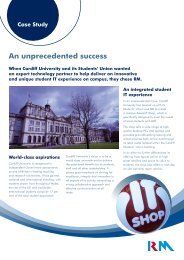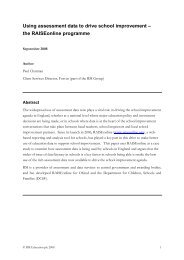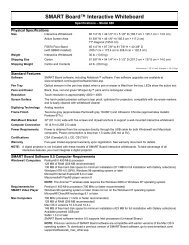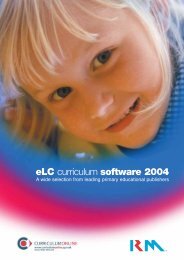The Primary Capital Programme - RM.com
The Primary Capital Programme - RM.com
The Primary Capital Programme - RM.com
You also want an ePaper? Increase the reach of your titles
YUMPU automatically turns print PDFs into web optimized ePapers that Google loves.
White Paper<br />
<strong>The</strong> <strong>Primary</strong> <strong>Capital</strong> <strong>Programme</strong><br />
Towards a Pedagogy of School Design<br />
PRIMARY SCHOOL BUILD TRANSFO<strong>RM</strong>ATION
<strong>The</strong> <strong>Primary</strong> <strong>Capital</strong> <strong>Programme</strong><br />
Towards a Pedagogy of School Design<br />
Contents<br />
Foreword<br />
Executive Summary<br />
1. <strong>The</strong> <strong>Primary</strong> <strong>Capital</strong> What?<br />
2. Towards a Pedagogy of School Design<br />
3. Partnership<br />
4. Next Steps<br />
5. Appendix A - <strong>The</strong> <strong>Primary</strong> <strong>Capital</strong> <strong>Programme</strong><br />
– A Roundtable Discussion Hosted by <strong>RM</strong><br />
2<br />
2<br />
3<br />
4<br />
8<br />
8<br />
See Appendix A<br />
Foreword<br />
Building Schools for the Future (BSF) has attracted much attention<br />
both in the world of education and in the general media – partly<br />
because of its focus on large secondary school rebuilding and<br />
partly because of its method of private finance. <strong>The</strong> more recently<br />
announced <strong>Primary</strong> <strong>Capital</strong> <strong>Programme</strong> (PCP) has received less<br />
attention, possibly because it is more modest in scope and finance.<br />
<strong>The</strong> aims of this short paper are to outline the background to PCP,<br />
to discuss some of the principles on which primary rebuilding or<br />
refurbishment may be built, and to stimulate debate and awareness<br />
of the PCP.<br />
To help begin the debate and inform this document, <strong>RM</strong> hosted a<br />
round table discussion between school leaders, advisers, journalists,<br />
educationalists and those involved in the implementation of new-build<br />
schools. A full transcript of the debate is available as an appendix<br />
to this paper.<br />
So, this document is part of an ongoing debate, to which we wel<strong>com</strong>e<br />
your contribution. We would be delighted to hear from you via our<br />
dedicated PCP web pages at :<br />
www.rm.<strong>com</strong>/primaryschoolsforthefuture<br />
Amanda Peck, <strong>RM</strong> <strong>Primary</strong><br />
December 2007<br />
Executive Summary<br />
<strong>The</strong> government has announced plans to rebuild and refurbish the<br />
primary school estate through its <strong>Primary</strong> <strong>Capital</strong> <strong>Programme</strong> (PCP).<br />
<strong>The</strong>re is not the same awareness of the detail and implementation<br />
of this programme as there is with other building programmes. In<br />
response to this, <strong>RM</strong> has sought to raise informed awareness of the<br />
programme, of which this paper is a part. <strong>The</strong> paper is informed by<br />
a roundtable discussion between educationalists; the paper invites<br />
further contribution and <strong>com</strong>ment.<br />
PCP is a government programme that over 15 years aims to provide<br />
separate capital funding for the replacement or modernisation of<br />
half of all primary schools in England, concentrating on the 5% of<br />
schools in the worst condition and those in the poorest condition.<br />
23 ‘Pathfinder’ local authorities (LAs) are currently engaged with<br />
the Department for Children, Schools and Families (DCSF) in<br />
submitting plans and testing processes for the programme. <strong>The</strong>se LAs<br />
will receive funding of £150 million in April 2008. It is very likely<br />
that funds will be used from other capital and revenue sources to<br />
supplement the PCP funding and thus ensure that the primary estate is<br />
developed.<br />
Recent criticism by the House of Commons Education and Skills<br />
Committee into the Building Schools for the Future (BSF) programme<br />
highlighted the need for full participation by schools in the planning<br />
process. To achieve this re<strong>com</strong>mendation, this paper proposes a<br />
pedagogical approach to school design <strong>com</strong>prised of three stages:<br />
a vision of education for the school is debated and developed;<br />
this vision is translated into architectural and building plans for the<br />
learning spaces; integrated ICT and furniture requirements are<br />
established.<br />
This pedagogy of school design is illustrated through a fictional<br />
example. Supporting examples are given from three schools,<br />
including Abbots Green Community <strong>Primary</strong> School where learning<br />
spaces have been designed to meet the physical, emotional,<br />
wondering and learning needs of its pupils.<br />
Managing a successful new build or refurbishment is <strong>com</strong>plex and it<br />
is unrealistic to expect head teachers to be able to do this in addition<br />
to the already considerable demands placed on them. <strong>The</strong> paper<br />
re<strong>com</strong>mends that successful long-term partnerships require shared<br />
vision, <strong>com</strong>munication, and leadership capacity.<br />
<strong>The</strong> paper concludes with a call to action for the discussion to<br />
continue and for schools to apprise themselves of the situation in their<br />
local authority.
1. <strong>The</strong> <strong>Primary</strong> <strong>Capital</strong> What?<br />
It’s a perfectly legitimate question- what exactly is the <strong>Primary</strong> <strong>Capital</strong><br />
<strong>Programme</strong> (PCP)? Well, to unpick the title, it refers to a government<br />
driven programme that, over 15 years, aims to provide separate<br />
capital funding for the replacement or modernisation of half of all<br />
primary schools in England. That’s England only – not Scotland or<br />
Wales. And it is capital funding not a leasing or PFI programme,<br />
unlike the secondary-focused Building Schools for the Future (BSF).<br />
<strong>The</strong> spotlight will be on schools in the most deprived areas and those<br />
in the poorest condition. This constitutes an estimated 45% of all<br />
primary schools in England. Its stated aims are to:<br />
• Fully equip primary schools for 21st Century learning, with<br />
schools at the heart of the <strong>com</strong>munity and children’s centres in<br />
reach of every family;<br />
• Support national policy aims such as raising standards and<br />
Every Child Matters;<br />
• Rebuild, remodel or refurbish at least half of all primary schools;<br />
• Address deprivation nationally and in every authority; and<br />
1<br />
• Respond to population changes.<br />
2<br />
• 23 ‘Pathfinder’ local authorities (LAs) are currently engaged<br />
with the Department for Children, Schools and Families (DCSF)<br />
in submitting plans and testing processes for the programme.<br />
<strong>The</strong>se LAs will receive their funding of £150 million in April<br />
2008.<br />
<strong>The</strong> timeline for the programme can be seen in Table 1 below.<br />
<strong>The</strong> pathfinder pilot aims to test the longer term programme structure,<br />
systems and monitoring; to deliver high-quality exemplar projects<br />
in each region; and to build capacity and share good practice<br />
regionally. <strong>The</strong> pathfinder LAs will be expected to share their<br />
experiences and the learning they have gained with other authorities.<br />
Date<br />
January 07- March 08<br />
Action<br />
DCSF tests processes with Pathfinder LAs<br />
Summer/Autumn 07 DCSF announces Indicative allocations for 2009-11<br />
November 2007<br />
DCSF provides guidance to LAs on requirement to prepare and<br />
agree primary strategy for change<br />
June 16, 2008<br />
Year 1 funding available to Pathfinder LAs<br />
Deadline for submission of strategies for change<br />
July /August 2008<br />
DCSF approves LA strategies.<br />
DCSF confirms indicative funding<br />
April 2009<br />
Year 2 funding available<br />
Sept 2009<br />
Pathfinder projects <strong>com</strong>plete<br />
April 2010<br />
Year 3 funding available<br />
2023 <strong>Programme</strong> ends<br />
Table 1: PCP Timetable<br />
Well, so far so good – a funded scheme to replace or refurbish the national school estate where the greatest need exists. But how might it apply<br />
in your school?<br />
Is this funding heading towards my school?<br />
And how much could I expect if it were?<br />
Let’s start with the amount of funding nationally. <strong>The</strong> grid below shows the first three years of the programme:<br />
Year<br />
PCP <strong>Capital</strong> Funding<br />
2008-2009 £500 million<br />
2009-2010 £650 million<br />
2010-2011 £1.1 billion<br />
2011-2023 £500m p.a<br />
Table 2: PCP Funding<br />
1<br />
Full details can be found in Every child matters: <strong>Primary</strong> capital programme at www.teachernet.gov.uk/docbank/index.cfm?id=9606<br />
2<br />
<strong>The</strong> 23 pathfinders are: Barnet, Birmingham, Bradford, Cornwall, Darlington, Ealing, Essex, Hampshire, Hertfordshire, Kent, Knowsley, Manchester, Newham, North Tyneside,<br />
Nottingham City, Rotherham, Sheffield, Solihull, Somerset, Swindon, Torbay, Waltham Forest, and Wigan.
This funding will be allocated via local authorities (LAs). By the end<br />
of March 2008, LAs will have submitted plans for the redevelopment<br />
of their primary estate in a document called, <strong>Primary</strong> Strategy for<br />
Change. You may well have been invited to participate in local<br />
consultations as the LA develops its plans. <strong>The</strong> exact funding<br />
allocations will be determined by the DCSF and this funding may well<br />
be supplemented by additional funds identified by the LA.<br />
One important point to consider is that Devolved <strong>Capital</strong> Funding<br />
(DCF) will be reduced or removed for schools benefiting from the<br />
PCP funding. Those schools not allocated PCP funds will continue to<br />
receive DCF. <strong>The</strong> DCSF document, Every child matters: <strong>Primary</strong> capital<br />
programme gives the example of how a “medium size local authority”<br />
with “medium deprivation” might receive £11 million new investment<br />
over two years. <strong>The</strong> document also points out that distributing the<br />
funding across all LAs does bring some “drawbacks” resulting in the<br />
need “to work harder to achieve efficiency savings.”<br />
You can probably see then, that the amount schools receive will<br />
vary considerably depending on local need and local context. <strong>The</strong><br />
fact that 23 ‘pathfinder’ LAs are participating in pilot schemes also<br />
indicates that there are still decisions to be made about the details of<br />
funding allocation.<br />
<strong>The</strong> funding provided by the <strong>Primary</strong> <strong>Capital</strong> <strong>Programme</strong>, bold though<br />
it is, is still insufficient to meet the ambitions and expectations of many<br />
authorities and schools. It is very likely that funds will be used from<br />
other capital and revenue sources to supplement the PCP funding and<br />
thus ensure that the primary estate is developed.<br />
Additional funding sources include:<br />
2. Towards a Pedagogy of<br />
School Design<br />
In the summer of 2007 the House of Commons Education and Skills<br />
Committee published the results of its enquiry into the Building Schools<br />
for the Future (BSF) programme. <strong>The</strong> <strong>com</strong>mittee was highly critical of a<br />
number of facets of BSF and the report offers some essential learning<br />
points for primary schools now embarking on their own programme of<br />
rebuild and modernisation. Perhaps one of the most striking <strong>com</strong>ments<br />
from the <strong>com</strong>mittee is this:<br />
“A regular theme in our evidence was that people involved in BSF,<br />
particularly at the school level, did not have sufficient time to think<br />
about what they wanted for their new school. <strong>The</strong> participation of<br />
teachers, other school staff and pupils in the planning process is vital<br />
to the success of school redevelopment projects, and this needs to be<br />
acknowledged by all those involved.”<br />
<strong>The</strong> report goes on to say that:<br />
“... those working in schools have a clear understanding of what<br />
is needed in a building to create a positive learning environment.<br />
Involving them in the earliest stages may require time, but will help<br />
to develop robust plans which will contribute to the success of the<br />
process.”<br />
All too often, as the experience of BSF indicates, the focus on school<br />
rebuilding is on architecture rather than education. Not only that, the<br />
vision for education in the new build schools is often ill-defined or<br />
unclear. <strong>The</strong> select <strong>com</strong>mittee has something to say on this too:<br />
“<strong>The</strong> crucial question here ... is what do we want education to be in<br />
the 21st century? “<br />
What we are re<strong>com</strong>mending in this paper is the need for a pedagogy<br />
of school design.<br />
<strong>The</strong>re are three stages to this.<br />
In the first stage, schools engage in a debate to develop a vision<br />
of education, Secondly, this vision for learning is translated into<br />
architectural and building plans for the learning spaces. Thirdly, the<br />
ICT and furniture requirements, to meet the needs of planned learning<br />
activities, are established.<br />
<strong>Capital</strong><br />
Revenue<br />
BSF<br />
SCHOOL FUNDING<br />
PCP<br />
LOCAL AUTHORITY<br />
ASSET UTILISATION GRANTS<br />
EXTERNAL FUNDING<br />
Table 3: Additional Funding Sources<br />
Figure 1: Towards a Pedagogy of School Design.<br />
<strong>The</strong> message in all of this is to engage closely with your LA. For<br />
many schools, this will be a once in a lifetime opportunity; close<br />
engagement, dialogue and partnership with the LA, with the local<br />
<strong>com</strong>munity, and with parents, staff , governors and pupils will<br />
be key factors for successful rebuild, modernisation and school<br />
transformation – as we shall explore in the rest of this paper.
Let’s follow the process that a school could adopt to achieve curriculum-focus in its new build or refurbishment. To do this, we’ll choose a<br />
fictional school, Abingdon Park <strong>Primary</strong> and its desire to create a learning environment that children and teachers want to learn and teach in.<br />
One that is safe, secure, inspirational, exciting, and wel<strong>com</strong>ing.<br />
(i)<br />
Vision Planning<br />
In our example, Abingdon Park <strong>Primary</strong> School begins to consider<br />
what its aims are for learning. Even at this early stage, dialogue and<br />
partnerships is important. Schools that have successfully managed<br />
this process, talk of the importance of involving local <strong>com</strong>munities,<br />
parents, staff, governors and the local authority. Developing a joint<br />
sense of ownership and a mandate for the vision are important steps<br />
in the building of the new school. What follows isn’t an exhaustive<br />
list, there could well be other things that you might wish to add, but<br />
let’s assume this is the basis for Abingdon Park <strong>Primary</strong>’s educational<br />
vision.<br />
• Embedding the principles of the five out<strong>com</strong>es of Every Child<br />
Matters<br />
• Developing effective and sustainable personalised learning<br />
• Engaging pupils in learning<br />
• Encouraging pupil voice<br />
• Embedding effective inclusion practice across the school<br />
• Ensuring breadth and depth in learning through more thematic<br />
teaching<br />
• Educating for sustainable development<br />
• Developing a professionally curious and qualified staff<br />
• Developing global citizens.<br />
(ii)<br />
Learning Space Design<br />
Different types of spaces support different styles of learning.<br />
Dr. Kenn Fisher 3 has developed the following image to illustrate this:<br />
Figure 2: Learning Spaces<br />
3<br />
Dr. Kenn Fisher 2006, Building Excellence -<br />
Linking the curriculum for excellence to the design of learning environments<br />
Abingdon Park School now starts to choose which type of spaces<br />
they will need to meet their curriculum aims. Again, <strong>com</strong>munication<br />
is important to identify the needs of different stakeholders. Parents<br />
will have concerns for the well-being of their children. Teachers may<br />
have concerns for the accessibility of learning resources. <strong>The</strong> local<br />
authority architect will have requirements to ensure buildings are<br />
energy-efficient and cost-effective. Bringing parties together at an<br />
early stage develops shared ownership and reduces the burden on<br />
individuals, especially the head teacher. Indeed, delegating tasks and<br />
building the capacity of staff to accept responsibilities are important<br />
considerations in themselves.<br />
Abingdon Park School’s plans for different spaces for different styles<br />
of teaching and learning include:<br />
• Collaborative working space<br />
• Flexible/moveable learning spaces<br />
• Accessible and secure storage space<br />
• Space for specialised use<br />
• Project space<br />
• Wet areas<br />
• Space for outdoor learning<br />
• Spaces for thinking & reflection<br />
• Display space<br />
• Breakout space<br />
• Presentation, large group space<br />
• Teacher meeting space<br />
• Dining, catering space.
(iii)<br />
Integrated ICT & Furniture<br />
the 21st century, primary schools are <strong>com</strong>plex organisations. School<br />
leaders and managers need access to timely and accurate pupil<br />
records, and need to share this data securely and safely with local<br />
authority and government agencies. Parental <strong>com</strong>munication can<br />
be enhanced considerably too through the use of ICT, for example<br />
through text-messaging services.<br />
Within the curriculum, ICT directly supports both teacher and pupil.<br />
In learning spaces where teachers present to pupils, teachers will<br />
use interactive whiteboards, data projectors and visualisers as key<br />
teaching tools. Pupils will use ICT for data-logging and control; for<br />
creativity in audio and video presentations; and to support research<br />
and independent learning. In areas where pupils are engaged<br />
in group-based work, mobile and laptop devices will be more<br />
appropriate. Learning spaces will need to be able to support this<br />
variety of learning through flexibility in furniture and space design,<br />
access to power and network connections, and storage space.<br />
Good primary school building design is not simply about physical<br />
shape, placement or structure. <strong>The</strong>re are many other features needed<br />
to achieve a wonderful learning environment, for example furniture<br />
and ICT.<br />
Because different types of spaces support different styles of learning,<br />
there will be a need for different types of furniture - with flexibility,<br />
ergonomic design, adjustability, ease of storage and safety being<br />
important considerations. To take that last point, safety. In areas<br />
where pupils move freely, cupboard doors that open <strong>com</strong>pletely<br />
back on themselves provide protection if pupils were to run into them.<br />
In areas where children will work collaboratively in research, tables<br />
that integrate power points and cabling will allow the easier use of<br />
laptop and mobile <strong>com</strong>puting devices.<br />
ICT provides a powerful set of tools for teaching and learning. Rather<br />
than being seen simply as PCs at the back of the classroom, ICT<br />
should be fully integrated into the teaching and learning. <strong>The</strong>re’s<br />
little doubt these days that a strong link exists between good ICT<br />
provision and high standards. Outside of the classroom, ICT has<br />
be<strong>com</strong>e ‘mission-critical’ for school management, assessment and<br />
inter-agency <strong>com</strong>munication. It makes considerable sense therefore<br />
for ICT to be an integral part of the design of a school. To ‘tack’<br />
ICT provision at the end of the build process will be inefficient and,<br />
ultimately, far less effective.<br />
As with furniture, ICT requirements will differ according to space<br />
and use. Some aspects of ICT can be seen almost in the same way<br />
that you would see something like electricity. A school building<br />
without electricity would be unthinkable today, as would a school<br />
without network infrastructure – certainly cabled and probably<br />
wireless. Other aspects of ICT provide essential foundations for ICT<br />
in teaching and learning: network servers, broadband access and a<br />
learning platform, for example.<br />
<strong>The</strong>re’s an essential administrative and management function to<br />
ICT that will also require planning at the outset. School life can run<br />
more smoothly and securely with the use of ICT for such purposes as<br />
electronic pupil registration, cashless catering systems and CCTV. In<br />
Figure 3: Integrated ICT<br />
Some of the ways in which furniture and ICT may support different<br />
learning spaces and different learning activities is illustrated in the<br />
following diagram.<br />
Figure 4: Integrated ICT & Furniture
3. School Design in Practice<br />
Although Abingdon Park <strong>Primary</strong> School is a fictitious example, the pedagogical approach to school design is something that is happening,<br />
in real schools. For example, Kingsmead <strong>Primary</strong> School 5 , Cheshire, has put sustainability at the heart of its educational vision to develop a<br />
learning school for the 21st century. <strong>The</strong> result can be seen in both curriculum and in buildings.<br />
Figure 5: Curriculum Aims to School Design<br />
Figure 6: Hierarchy of Needs at Abbots Green<br />
In a central city location where space is at a premium, Hampden<br />
Gurney School 6 , Westminster has ensured that the space provided is<br />
driven by a focus on learning to create a multi-level ‘vertical school’<br />
over six levels. Age-banded ‘play decks’ provide all-weather, easy<br />
access, multi-functional spaces. <strong>The</strong> curriculum need for extended<br />
learning classroom space and a space for curriculum enrichment in<br />
science, arts, geography has resulted in the creation of a Technology<br />
Garden. <strong>The</strong>re have been drawbacks, for example high energy<br />
consumption, but the lack of physical space for building has not<br />
hampered the curriculum vision for the built environment.<br />
Our final example is Abbots Green Community <strong>Primary</strong> School 7 in<br />
Bury St Edmunds, a new build first phase school in Bury St Edmund’s<br />
tertiary middle-school system. Here, head teacher Alex Bedford has<br />
worked closely with teachers, parents, the local authority, builders,<br />
architects and pupils in creating practical, efficient and motivational<br />
learning spaces – both indoors and outdoors. What sets the building<br />
apart is its strong curriculum vision foundation. <strong>The</strong> school vision<br />
is based on Maslov’s hierarchy of needs but translated into more<br />
readily understood terms. At the base of the triangle are ‘physical’<br />
needs, followed by ‘emotional’, ‘wondering’, and ‘learning’ needs.<br />
<strong>The</strong> entire school building is designed to meet these needs.<br />
For example, the building’s orientation ensures that plenty of natural<br />
light is available but also ensures that no direct sunlight intrudes<br />
harshly into the learning spaces. <strong>The</strong> simple direct layout means<br />
that children are never lost, while the strategic use of windows<br />
ensures that children can always be seen. Sustainability has been an<br />
important part of the development too. Once again, the link between<br />
learning and the built environment has been consciously planned. For<br />
example, the school takes advantage of the learning opportunities<br />
provided by the wildlife-encouraging energy-efficient grass roof.<br />
Technology has a part in creating these supportive and inspirational<br />
environments too. Positioned around the school are LCD screens that<br />
automatically display images and play sounds at breaks, lunchtime<br />
and other changes of school day without bells. It’s part of the<br />
intention to create a calm atmosphere and extend the school’s highly<br />
effective practice in inclusion to all children in the school. This can<br />
also be seen in the sensory room, which is used widely across the<br />
school. ICT is fully embedded throughout the school, for example in<br />
wireless whole-school network, mobile learning technologies and<br />
the use of DVDs and digital resources for interactive whiteboards.<br />
<strong>The</strong>re is also a dedicated sensory room that not only supports the<br />
physical and emotional needs of young children but also provides a<br />
space for wonder and learning. It’s an example in a nutshell of how<br />
the curriculum vision has driven the out<strong>com</strong>e of physical building and<br />
used technology creatively.<br />
5<br />
www.kingsmead.cheshire.sch.uk<br />
6<br />
www.hampdengurneyschool.co.uk<br />
8<br />
www.abbotsgreen.co.uk
4. Partnership<br />
Talk with schools engaged in the process of rebuild and refurbishment<br />
and one thing be<strong>com</strong>es very clear: head teachers cannot manage<br />
this process alone. This is no criticism of head teachers. It’s simply<br />
recognition of the fact that the skill-base and capacity of head<br />
teachers does not extend to school rebuilding, and why should it?<br />
However, when head teachers are involved at an early stage and<br />
throughout, an out<strong>com</strong>e where the school is delighted with its new<br />
facilities is more likely.<br />
<strong>The</strong> key, therefore, is partnership.<br />
Partnership is built on three assets:<br />
• Shared vision<br />
• Communication<br />
• Leadership capacity.<br />
A successful partnership built on these principles is also one that is<br />
more likely to stand the test of time and lead to successful long-term<br />
relationships.<br />
(i)<br />
Shared vision<br />
Building a shared vision extends to the whole-school <strong>com</strong>munity;<br />
to parents, local business, staff, governors and pupils. <strong>The</strong> Sorrell<br />
Foundation 8 , for example, has a Joinedupdesign process for<br />
developing small and large projects in school with the active<br />
participation of pupils in working with architects and planners. Pupils<br />
act as clients. Clearly there are many opportunities for learning too.<br />
<strong>The</strong> programme itself may not transfer exactly to your circumstances<br />
but there is a lot to be gained from its principles and practice. <strong>The</strong><br />
foundation has also established a Young Design Centre to explore<br />
what young people want from design at school.<br />
Parents too will have a keen interest in the development of the school.<br />
Central to parents’ concerns are the health, safety and well-being of<br />
their children. Experience suggests that early involvement of parents<br />
in the planning process helps create strong practical and moral<br />
support for the project. <strong>The</strong> same is true of staff and governors. Local<br />
businesses are an often neglected area of interest and support.<br />
In many ways, this is about developing a shared vision for the school;<br />
as the vision develops across the different stakeholders, so too does<br />
support. It be<strong>com</strong>es a mandate for change<br />
Figure 7: Partnership<br />
(ii)<br />
Communication<br />
Implicit in this vision-building process is need to <strong>com</strong>municate<br />
openly and regularly with all partners in the project. Channels for<br />
<strong>com</strong>munication include presentations, meetings, visits, email, school<br />
website and newsletters. <strong>The</strong> practice of <strong>com</strong>munication should also<br />
be managed within the project partners. For example, there may be<br />
different suppliers providing furniture, ICT, play items, books and<br />
resources. Insisting on a means of <strong>com</strong>munication where suppliers<br />
<strong>com</strong>municate with each other can save considerable time and energy.<br />
<strong>The</strong>re’s an important additional benefit too when schools can ask<br />
suppliers to seek and source innovative solutions rather than trying to<br />
do this themselves.<br />
Figure 8: Supplier Communication<br />
(iii)<br />
Leadership Capacity<br />
<strong>The</strong> process also hinges on the ability of head teachers to delegate.<br />
At the same time as leading and managing a busy school, head<br />
teachers are expected to be actively involved in their new build or<br />
refurbishment. This will not be achievable unless there is some means<br />
of building capacity. At Abbots Green Community <strong>Primary</strong> School,<br />
building capacity meant sharing leadership and developing the skills<br />
of more junior staff.<br />
Partners in this process also include those agencies external to the<br />
immediate school <strong>com</strong>munity. Working closely with builders and<br />
architects will be essential if the vision developed with the school<br />
<strong>com</strong>munity is to be successfully implemented.<br />
Central to this whole process is the local authority - likely to be your<br />
key partner in the development of the project, from identification of<br />
need, through planning and to project <strong>com</strong>pletion. Expertise exists in<br />
local authorities that it would be unreasonable to expect in the school.<br />
Forging a strong partnership with the LA helps extend the capacity<br />
of the head teacher. For example, procurement is a specialist area of<br />
expertise and experience. It makes considerable sense therefore for<br />
local authorities to be central to the three-way supplier/LA/school<br />
relationship.<br />
5. Next Steps<br />
In this document we have re<strong>com</strong>mended a pedagogical approach<br />
to school design for new build or refurbishment and we have<br />
emphasised the importance of partnership; principles that are<br />
informed by a recent roundtable discussion between school leaders,<br />
advisers, journalists, educationalists and those involved in the<br />
implementation of new-build schools. We would very much like to<br />
extend this discussion. Perhaps you will want to share this document<br />
with colleagues and use this as a basis for your own thinking?<br />
If you are a school leader, one starting point could be to contact your<br />
local authority and discuss its plans for PCP. Perhaps you have had<br />
notification of plans affecting your school, in which case you may be<br />
beginning the process of building the vision across your whole school<br />
<strong>com</strong>munity. Perhaps, action has already begun and you are already<br />
engaged in building partnership.<br />
Whatever your circumstances, we hope this document and its<br />
ac<strong>com</strong>panying web pages provide a useful source of information and<br />
a stimulus for further debate.<br />
Do visit us at www.rm.<strong>com</strong>/primaryschoolsforthefuture where you will<br />
find useful materials and means of <strong>com</strong>munication.<br />
8<br />
www.thesorrellfoundation.<strong>com</strong><br />
08450 700 300 08450 700 400<br />
psf@rm.<strong>com</strong><br />
www.rm.<strong>com</strong>/primaryschoolsforthefuture<br />
Research Machines plc, New Mill House, 183 Milton Park, Abingdon, Oxon, OX14 4SE
















